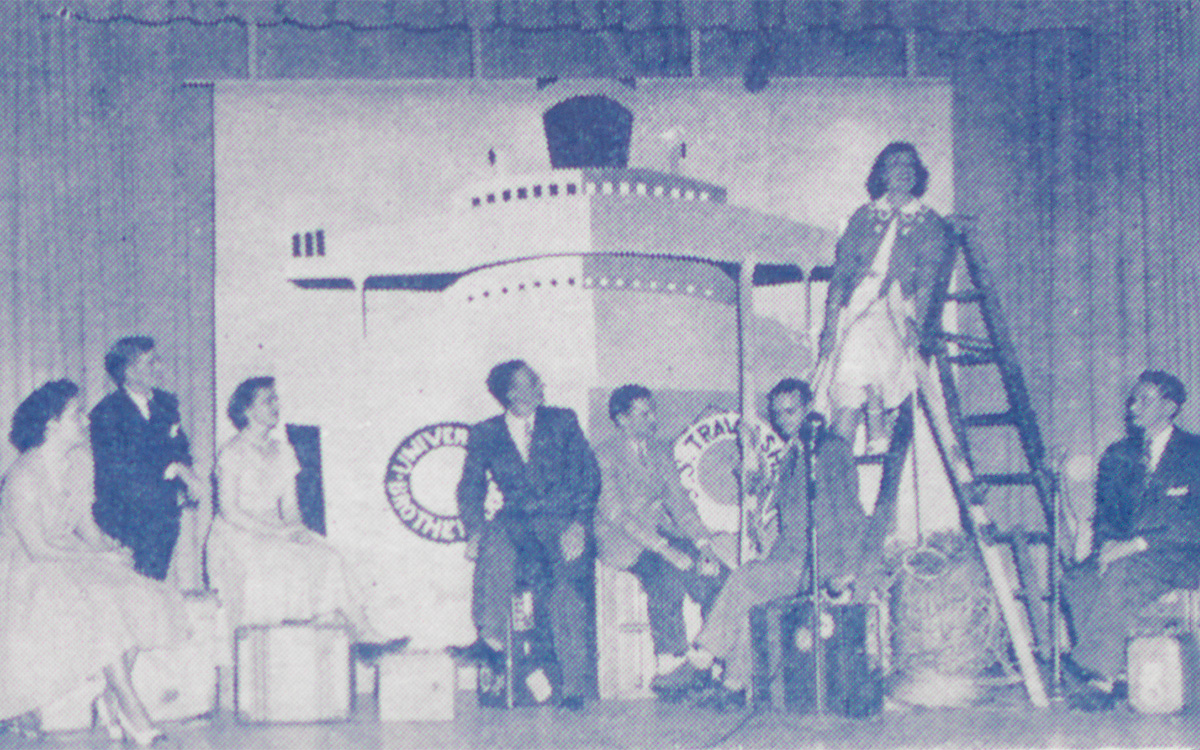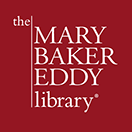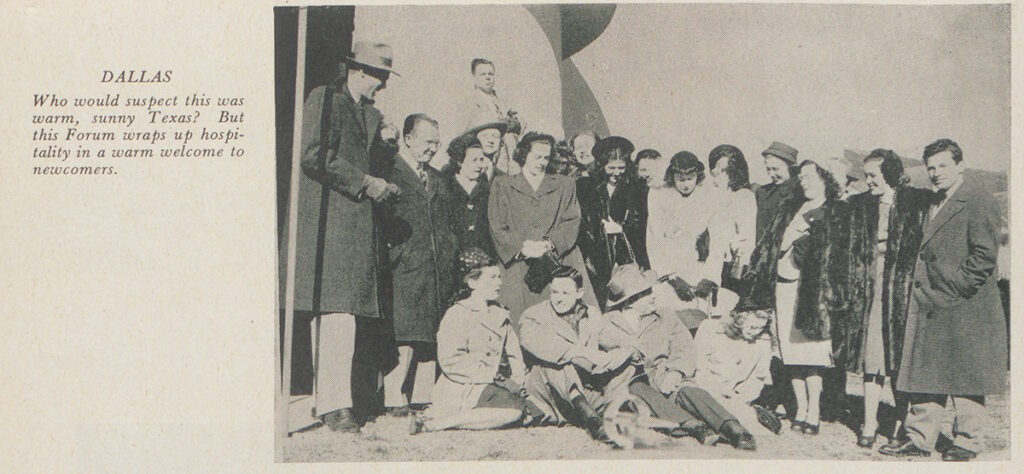From the Collections: Christian Science Monitor Youth Forums—a unifying activity

Monitor Youth Forum travelship award recipients present to an audience in Boston, around the time of The Mother Church’s Annual Meeting. Undated photo. What You Should Know About The Christian Science Monitor Youth Forums, 1952, p. 7. Church Archives.
First established in May 1946, Christian Science Monitor Youth Forums united young people interested in promoting greater tolerance and understanding in the world. Based on the values of democracy and Christian Science teaching, these gatherings were soon found in many cities and towns across continents.
A new voice for young people
The Forums were social and educational clubs, consisting of Christian Scientists between the ages of 16 and 30. Organized and operated independently, they were associated with one another through an office that The Mother Church (The First Church of Christ, Scientist) established near its Boston headquarters. This office set standards and provided support to groups as they developed programming.1 As of April 1948, there were approximately 300 Forums, with a total of around 15,000 members.2 Despite their name, the Monitor Forums were not directly affiliated with The Christian Science Monitor. Groups read and utilized ideas presented in that newspaper, but there was no active relationship.3
Within post-World War II society at the time, there was a desire to employ the voice and talents of youth as a means of diplomacy. At that time, according to author Catherine Bishop, “Mass festivals, university exchange programs, and even scouts and guides were all soft-power weapons.… young people supposedly also embodied their idealized Western or communist cultures.”4 The Monitor Forums were specifically designed to encourage young people to make use of ideas and concepts presented in the Monitor, while at the same time providing for social activities among like-minded Christian Scientists. But their organizational structure, along with some of the programming, did tie into a larger view of youth as promoters of Western political norms.
A 1946 article in the Christian Science Sentinel summed up the founding purpose of the Forums:
For several years prior to the establishment of The Christian Science Monitor Youth Forums … The Christian Science Board of Directors received much correspondence on the subject of social activities among young Christian Scientists. It was learned that about seven hundred clubs had been organized by our young people in the United States and Canada. It became clear that many of these groups needed guidance in their efforts to uphold the ideals of Christian Science in their activities. The establishment of the Headquarters Secretary for The Christian Science Monitor Youth Forums at 237 Huntington Avenue, Boston, is intended to meet this need.
These forums are not official activities of The Mother Church or its branches, but they are activities of groups of young Christian Scientists which have the sympathetic interest of the Board of Directors, provided certain standards, which are set up for them through the office of the Headquarters Secretary, are maintained….5
Organizational structure
These were formal organizations, with constitutions and officers. New Forums that met certain standards could be recognized with a membership certificate. The Boston office also reviewed organizing documents and required that Forums renew their affiliation annually, through a process that included electing officers. Forums raised their own operating funds, through membership dues and other fundraising activities.6
Members were encouraged to hold regular business meetings, as a way of protecting democratic norms within wider society. One informational booklet introduced the section on business meetings with this question: “Have you ever stopped to consider that business meetings are a bulwark for democratic processes, which appear to be under attack from every side in the world today?”7
Monitor Youth Forum in Dallas, Texas, c. 1948. Second Annual Pictorial Review, c. 1948. Church Archives.
Forum activity was intended to model international cooperation in a post-World War II world. When traveling or moving, members who held a “Forum pin” and membership card could seek out and connect with other chapters.8 Forums also corresponded with and supported one another across national borders. In response to a package of clothing and food sent from the United States, one German Forum member wrote, “When I arrived at home the parcel was there as substantial proof of the divine Love and the unity of Christian Scientists in all countries.”9
Another participant, from Buenos Aires, wrote:
… I am particularly happy to be taking an active part in The Christian Science Monitor Youth Forum. Seldom a meeting goes by without giving a practical proof of what the Monitor is doing for young Christian Scientists in giving them a more expansive view of the brotherhood of man. The Monitor is breaking the barriers of selfishness, fear, and language difference; thus it gives a clearer vision of the one Mind which governs and directs all.10
Activities for younger participants
Around October 1947 the Board of Directors launched Junior Youth Forums, intended for children ages 7 to 15. Unlike the Monitor Youth Forums, this initiative was intentionally started without publicity—it appears even the Editor of the Monitor at the time, Erwin Canham, was initially unaware of their existence.11 As with the Monitor Forums, Junior Forums were not affiliated with Christian Science branch churches, nor were churches allowed to host or advertise Junior Forum activities. Junior Forums were organized similarly to the Monitor Youth Forums, but with the involvement of adult advisors. Members could hold elected office in the Forums. Parents and other interested church members could join an affiliated “Parents and Friends group” to raise funds, provide transportation, and host meetings at their homes.12
Hi-Teen was the name given to Forums whose members were exclusively between the ages of 16 and 20. At different times, the term also referred to a category of older participants in the Junior Forums. Hi-Teen Forums could only be formed in areas where there were no other active Forums, and they did not necessarily exist as a transitional activity between the Junior Youth Forums and the Monitor Forums. Rather, it was hoped that Hi-Teen Forums would morph into regular Forums at some future point. These groups were supported by two adult advisors.13
What did Forums do?
As independent organizations spread over many geographic areas, Forums hosted activities of interest to their own members, whatever the age group. In January 1949 members of several different Forums participated in a program in Boston, on the topic of “Plan E for Boston City Government.” Open to both Forum members and their guests, it consisted of roundtable discussions and a mock election. The event attracted 200 attendees and was covered in the Monitor.14 Forums also planned general educational programming. For instance, a group in Glasgow, Scotland, explored together the history of fashion, using cardboard cut-outs and sewing materials so that participants could create their own reproductions of historic clothing designs.15
The Boston office encouraged Forums to create programs that were inspired by Monitor content or that made active use of it. One Forum utilized contemporary Monitor articles about Russia to create and act out a jury trial, answering the question “Has Communism elevated or subjugated the Russian people?” Cartoons published in the Monitor about Russia lined the walls. The production was also enhanced with an “iron curtain” made of black crepe paper, a large reproduction of the scale of justice, and Russian music.16
Social activities and connections with other young Christian Scientists were an important aspect of all these activities. Forums planned regular hikes, picnics, dances, and other types of gatherings. One Forum in London described their “Country Ramble in Surrey”—an all-day trip where 15 members explored the countryside (in the pouring rain).17 One participant in an unknown Forum emphasized the importance of social connections:
… I am also grateful that I was a member of The Christian Science Monitor Youth Forum. It was a wonderful experience to be able to go about with young people who shared the same high standards and interests. I met my husband in the Forum. He was a member of a different branch Church of Christ, Scientist….18
The Youth Forum trend
Organizations of this type were not unique to the Monitor. In fact, the concept had wider appeal in the immediate Post-World War II era, albeit in slightly different formats. Known by different names over time, the New York Herald Tribune Forum ran from 1946 to 1964, and later became known as the World Youth Forum until 1972. This program consisted of moderated discussions on major world issues. Discussions were broadcast first on radio and later on television, in a program called The World We Want. Starting in 1947 participants hailed from many different countries, and the broadcast discussions were actually the culmination of a three-month stay in the United States. As a way of promoting American life and ideas, participants would live with American families, visit Washington, DC, and meet major political figures. Other youth forums included (but were not limited to) the London-based Daily Mail World Youth Forum, as well as The New York Times Youth Forums,19 where topics posed included use of atomic weapons, labor relations, and the role of the United Nations.20
Monitor Youth Forum activity ad from a Forum in Waukegan, Illinois, as reproduced in Trade Wind, August 1947. Church Archives, Box B20141, Folder F122446.
An international effort
The New York Herald Tribune travel program is echoed in a “travelship” program sponsored by the Boston office of the Monitor Youth Forums. The earliest travelship was granted in July 1947, funding travel to the United States, so that visitors could experience American culture and institutions firsthand. Recipients would then return to their home countries and report on their impressions to Forums in their area.21 At some point the scope of the program expanded to also allow American members to visit other countries around the world, supporting international unity and understanding. Travelships were not directly funded by The Mother Church or its branch churches but rather through individual donations to funds managed in different countries. Local Forums and Christian Science Committees on Publication were involved in selecting recipients. By around 1952, a total of 44 Forum members from 11 countries had participated in the program.22
A time for something new
On December 31, 1959, the Forum’s Headquarters Secretary’s office in Boston was closed. The closure announcement stated that the goals regarding the Forums had been met by that point and that young people were now taking on a larger role within Christian Science branch churches.23 A 1967 announcement from the Board of Directors clarified the decision further:
… there was an increasing tendency to assume that the sponsorship and supervision of the Forums was the responsibility of the Headquarters Secretary—a responsibility which this office could not possibly fulfill. The Headquarters Secretary’s office was, therefore, discontinued ….24
It was expected that Forums might continue informally after 1959; Margaret Robbins, then Headquarters Secretary, requested that the words Christian Science and Monitor not be used in conjunction with these informal activities. Additionally, she stipulated that remaining travelship funds were to be used for funding travel to Boston-based youth meetings (also known as “biennials”).25 The first such meeting had been held in 1955 and had proved quite popular.26 Some youth forums and junior forums did continue operating after 1959. While as originally conceived these activities reflected a post-World War II society deeply invested in international progress, The Mother Church continues supporting youth through avenues that best meet the needs of a changing society.
- “Christian Science Monitor Youth Forums Launched,” The Christian Science Monitor, 7 May 1946, 3. Although the Forums were independently run by their members, the primary Forum newsletter, Trade Wind, included frequent calls for proper group behavior and appropriate activities, including a strong stance against holding dances on Sundays. Policies and other guides on how to conduct meetings were issued to Forums, making it somewhat difficult to discern just how independent the groups really were.
- “Youth Forum Award Speeds Berlin Student to U.S. College,” Monitor, 22 April 1948, 9.
- Monitor Youth Forums were also distinct from Christian Science organizations (CSOs) at colleges and universities. CSOs are opportunities for students and faculty to publicly practice Christian Science in a school setting, and are provided for in the Church Manual under Article XXIII, Section 8.
- Catherine Bishop, The World We Want: The New York Herald Tribune Forum, and the Cold War Teenager (Melbourne: Australian Scholarly Publishing, 2024), 3.
- “Item of Interest,” Christian Science Sentinel, 17 August 1946, 1432-1433.
- “How you can start a Christian Science Monitor Youth Forum,” Church Archives. Forums were not listed in The Christian Science Journal directory as official activities of The Mother Church.
- What You Should Know About The Christian Science Monitor Youth Forums, undated, 31; Church Archives. Although not explicitly stated in this booklet, Library staff suspects that participation in Forum business meetings was also considered a way for youth to be introduced to the logistics involved in branch church business meetings.
- What You Should Know About The Christian Science Monitor Youth Forums, undated, 27; Church Archives.
- “Hands Across the Sea,” Trade Wind, November 1947, 2; Church Archives, Box B20141, Folder F122446.
- Patricia Atherden Clinton, Testimony, Sentinel, 19 November 1955, 2068.
- Memo, Erwin Canham to Board of Directors, 24 October 1947; memo, Laura Haddock to Canham, 22 October 1947. Church Archives.
- The Christian Science Monitor Junior Forum Handbook, 3rd edition, c. 1953, 7; Church Archives.
- The Christian Science Monitor Youth Forums’ Policy Digest, February 1956, 5; Church Archives.
- “Plan E for Boston City Government Discussed at Monitor Youth Forum,” Monitor, 29 January 1949, 2. The article does not specify whether the event was sponsored by the headquarters office, but it appears to have taken place there (the address for the Forum office changed several times). Forum activities were not typically reported on by the Monitor during this time. However, between 1953 and 1955 the Monitor published contributions from Forum members almost weekly.
- Louis Garinger, “Is Your Club Creative?” Monitor, 27 August 1953, 15.
- What You Should Know About The Christian Science Monitor Youth Forums, undated, 41; Church Archives.
- Arthur W. Scruton, “Country Ramble in Surrey,” Monitor, 1 October 1953, 19. Although the hike is not specifically described as a Forum activity in this article, the author is identified as a Forum member.
- Sheena C. Gilchrist, Testimony, Sentinel, 28 June 1969, 1132.
- For more on this topic, see Catherine Bishop, The World We Want: The New York Herald Tribune Forum, and the Cold War Teenager. (Melbourne: Australian Scholarly Publishing, 2024).
- For digitized recordings of The New York Times Youth Forum events, see https://www.wnyc.org/series/new-york-times-youth-forum.
- Letter, Elizabeth Woolley to Erwin Canham, 29 July 1947, Church Archives, Box B20141, Folder F122446. Woolley was the first (and longest-serving) Headquarters Secretary for the Monitor Youth Forums. Canham declined this last-minute invitation to the first travelship presentation ceremony.
- What You Should Know About The Christian Science Monitor Youth Forums, undated, 45–47, 62–63, Church Archives. Travelships were not advertised or announced in the Journal or Sentinel. However, an article in the August 1980 Journal noted that David C. Driver, the new First Reader of The Mother Church, had received a travelship (referred to as a “travel scholarship”) when younger. See “New Readers of The Mother Church,” Journal, August 1980, 435.
- See “The Christian Science Monitor Youth Forums,” Journal, November 1959, 600.
- Directors, “Status of the Youth Forums,” Journal, May 1967, 255.
- Circular letter from Margaret E. Robbins, 16 November 1959, Church Archives.
- For more on this, see “From the Collections: A History of Christian Science Youth Meetings,” https://www.marybakereddylibrary.org/research/from-the-collections-a-history-of-christian-science-youth-meetings/



